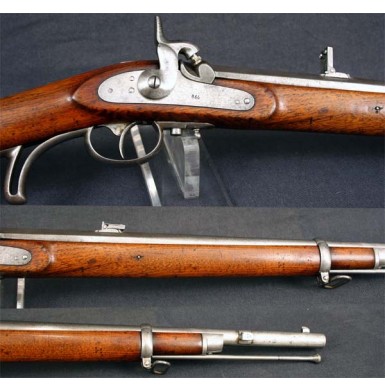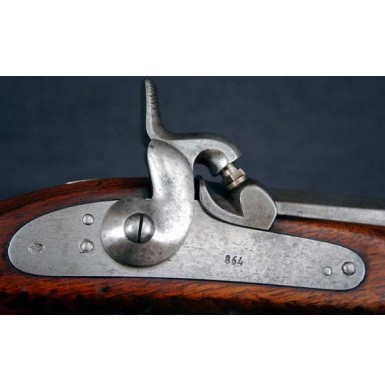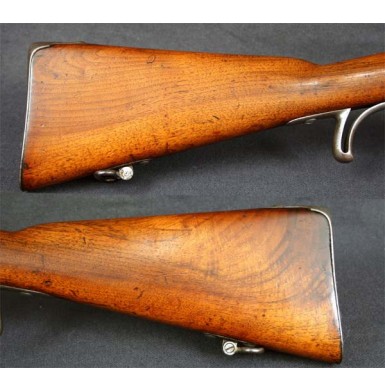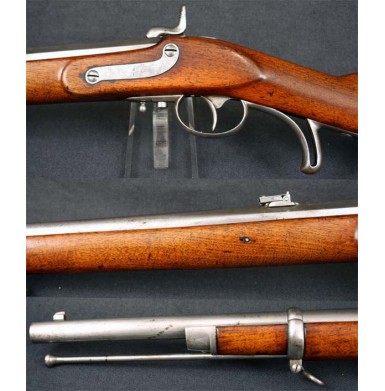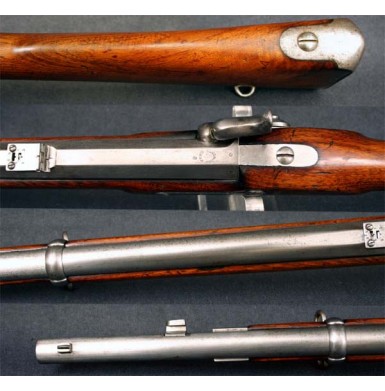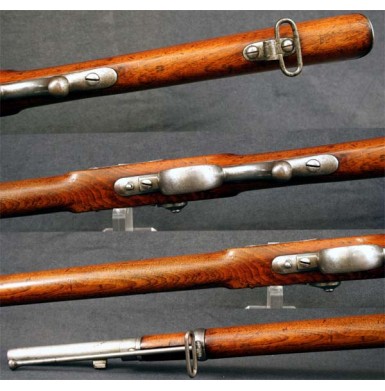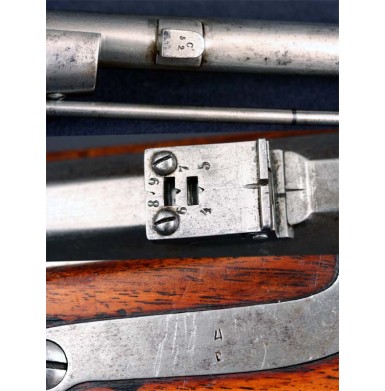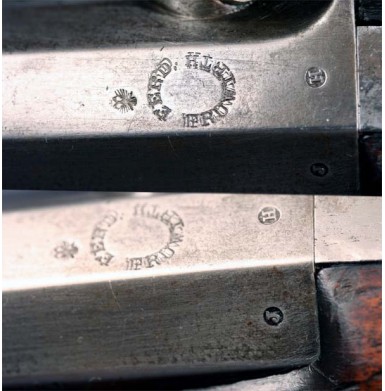Austrian M-1862 Artillery Musketoon -EXCELLENT
- Product Code: FLA-1172-SOLD
- Availability: Out Of Stock
-
$1.00
This is a really gorgeous example of a gun I have never seen before, and I have to admit I am trying to determine exactly what it is. Until I can find better documentation, I will refer to it as an Austrian M-1862 Lorenz Artillery Musketoon. The gun is based on the classic Austrian System Lorenz. The Lorenz series of arms were the first Austrian arms produced as percussion weapons, replacing the earlier Augustine-Consol Lock, often called by the nickname Pill-Lock. The Austrian’s built a whole series around the M-1854 Lorenz rifle musket, including the M-1854 Jaeger (short) rifle, and the M-1854 single shot cavalry pistol. All used the same gracefully curved lock plate and percussion ignition system. They also featured an octagon to round barrel system, with the Jaeger rifle retaining the octagon barrel all the way to the end of the stock and only becoming round for the last few inches to accept the cumbersome socket saber bayonet that was similar to the old Garibaldi rifle bayonet. In 1862, the Austrian’s refined the series a little and made them somewhat more “Enfield” like in appearance. This was primarily noticeable in the shape of the lock plate and the snail (bolster). The M-1862 series lock plates were thinner than their predecessor M-1854 lock plates and were flush fitting with the stock. The M-1854 plates were thicker and beveled. The M-1854 plate also had an upward projection forward of the bolster, which is noticeably missing from the M-1862 series of arms. In typical Austrian fashion, one basic design was all that was necessary for a whole family of arms, and a variety of Extra-Corps long arms were produced based on the same pattern. This appears to be one of those arms, and based upon the features, I believe it to be an Artillery musketoon.
The gun has an overall length of 40.5” with a 24.5” barrel. The barrel is .54 caliber and retains the typical Austrian 4-groove rifling. The bore is truly in mint condition, and is bright with very sharp lands and grooves. The gun features the flat, flushing fitting M-1862 series lock plate, and is clearly marked with the Austrian Eagle to the rear of the hammer and 864 forward of the hammer, indicating production in 1864. The lock is very crisp and works perfectly on all positions. The gun features a combination of Austrian and English design features. From the rear site back, the gun is classic Lorenz in design and appearance. However, the muzzle end of the gun has features one would expect to find on an Enfield artillery carbine. The gun does not have the classic double strapped front barrel band / nose cap, but rather an English or US pattern metal forend tip. Also, instead of the typical offset oval front site / bayonet stud, a more traditional saber bayonet stud is dovetailed into the side of the barrel. Also, the single barrel band is of the English Palmer clamping band pattern instead of the more typical Austrian pattern of a flat solid band retained by band springs. The rear site is a classic Austrian design, calibrated to 900 yards (or meters) and is based on the long-range leaf site seen on Lorenz rifle muskets. However, the site is resized to be appropriate to the much shorter sight-radius of the 24.5” barrel. The gun is clearly marked on the breech by it’s maker FERD FRUWIRTH. The mark is double struck, as if the die skipped when the mark was struck. Ferdinand Fruwirth was one of the most prolific and famous Austrian arms makers of the time. The breech is also clearly marked with the Austrian Eagle proof, as well as a J and an H, both in circles. All markings are very clear and crisp. As is typical of Austrian military arms, the gun is stamped with a variety of assembly marks. The lock has all parts numbered 26, while many of the larger parts are stamped with a 4. The front barrel band is marked C / G and the bayonet lug is stamped C / 52 to mate it to a bayonet. The gun retains both of the original sling swivels, with the upper swivel attached to the single barrel band and the lower swivel attached to a plate near the toe of the buttstock. The gun has the iron pistol-gripped trigger guard found on the M-1854 Lorenz Jaeger rifle, and has a mount attached to the front of the trigger guard for the attachment of a British style snap cap or cone protector. The snap cap and chain are missing. The gun also retains what appears to be a period original ram rod, although it does not have the normally expected brass band around the tulip shaped head. The rammer is exactly the right length, has perfect threads at the end is clearly not of modern origin. However, I cannot be sure that it is the correct ramrod for the gun, because I have not seen one before. The gun is in excellent condition throughout with wonderful, smooth metal that show practically no pitting or roughness, and only scattered light age discoloration and minor peppering. The stock is in equally fine condition, with no breaks, cracks or repairs. Only the most minor handling marks and minor rubs and dings are present on the excellent stock. There are a couple of stamped markings on the underside of the stock, between the trigger guard and swivel, and between the swivel and the butt. However, neither are clearly legible.
The overall length of the gun, the presence of sling swivels (instead of a carbine sling bar or ring system) and a saber bayonet lug lead me to believe that this musketoon was designed for use by the Artillery or possibly Engineers. The overall design is very similar to the British Enfield Artillery musketoon and provides a good comparison. Older pattern Austrian arms intended for use by the Engineer corps were typically infantry arms that had been shortened slightly, with the barrels normally 3”-6” shorter than the comparable infantry musket. This gun is so much shorter that it does not fall into the pattern for Engineers rifles. While I cannot in any way conclusively argue that these carbines may have been made for export to the Confederacy, I would like to point out that as the war drug on, Confederate imports of Austrian arms increased dramatically. Additionally, if one examines blockade-runner manifests like those contained in the Payne Papers you will notice that a large number of undesignated carbines were imported in the last half of the Civil War. These same papers always list British carbines as British or Enfield pattern. Thus the origin of these other carbines is sort of a mystery. It is interesting to note that these carbines often show up on manifests with Austrian Lorenz’s and other Austrian items, so it may not be a stretch to assume that the undesignated carbines may be of Austrian origin as well. It is also interesting to note that a similar Austrian pattern 2-band rifle appears on page 269 of Civil War Guns by William B Edwards. The gun has two-barrel bands and a metal forend tip, along with a saber bayonet lug and an iron tulip-head ram rod. The gun is noted to be Liege made and one that uses Austrian components, finished like an Enfield, originally produced for sale to Mexico. The author claims that the guns were diverted for sale to America during the war and were likely imported for US use by Herman Boker. What this does indicate is that non-standard Austrian style arms were likely produced both in Liege (and likely in Austria) for sale to the American combatants. The 1864 production date rules out US purchase (all US foreign contracts were cancelled in July of 1863), but surely leaves the possibility of CS purchase. One way or another, this is a rare example of a truly excellent condition Austrian specialty long arm and would be a find addition to any foreign arms collection.
SOLD


